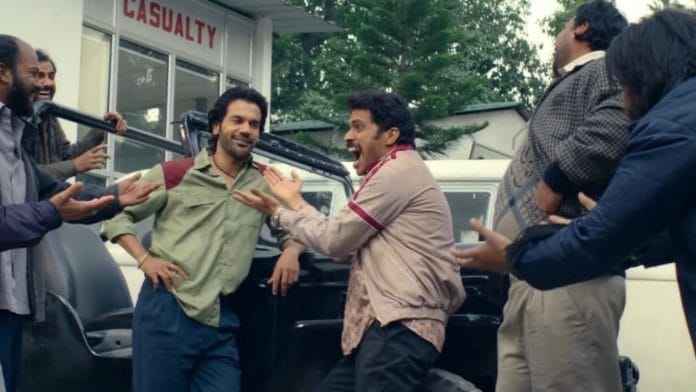A character in Raj and DK’s Guns & Gulaabs plots revenge against the murderer of his best friend, only to be reminded by someone that he must avenge his father’s killer too. A typical heavy crime thriller moment – except that comedy changes its tonality instantly. Like salt to taste, comedy can refine and define a scene.
Of late, the comedy genre is disappearing from the silver screen, not just in Hindi cinema but also in Hollywood. While some blame the pandemic for this change in viewer preference, others say that the definition of comedy has changed over the years. But the advent of OTT has ensured that comedy evolves and thrives in the company of genres like crime.
In the last five years, with projects such as Ludo (2020), Loop Lapeta (2022), Monica, O My Darling (2022), Good Luck Jerry (2022), and Kathal (2023), crime comedy has evolved to be a reliable and entertaining genre. It is, in fact, genre-blending at its finest.
“As a filmmaker, we don’t see a film or a series as a comedy genre. If a situation warrants comedy, it becomes funny. Comedy is a vehicle or a tool that I think we organically tend to use in any story and put quite a few things across about human behaviour and psyche satire,” says Raj Nidimoru of the writer-director duo Raj and DK, adding that a lot can be said with humour, which is why filmmakers have been using it increasingly in their projects.
The plot thickens more when the exasperations of daily life are interspersed with humour and idiosyncratic characters. As seen in Kathal and Guns & Gulaabs, this is further enhanced by satire cleverly masquerading as realism and age-old conflicts disguised as modern crises.
Also read: Lazy writing drowns Neeyat, Blind, Gaslight. Bollywood just doesn’t get whodunit right
The evolution – and death – of slapstick humour
It would be a crime to talk about comedy and not mention the master of comic timing and writing – Priyadarshan. With classic capers such as Hera Pheri (2000), Hungama (2003), Garam Masala (2005), Malamaal Weekly (2006), Chup Chup Ke (2006) and Bhool Bhulaiyaa (2007), Priyadarshan redefined comedy in Bollywood. He had once famously said that he measures the humour in his movies by the width of his smile.
For a majority of the generation growing up in the 1990s or after, Priyadarshan’s movies have been staples. Most of his films thrived on situational comedy but adept writing and dialogues interspersed with emotional love arcs helped make them classics.
From the comedy of errors that ensue when Anjali’s lies come to the surface in Hungama or when a dead body comes back to life in Malamaal Weekly, slapstick comedy popularised by the likes of Priyadarshan became the go-to modus operandi for filmmakers wanting to get audiences to laugh their heart out.
David Dhawan’s Judwaa (1997), Hero No. 1 (1997), Biwi No.1 (1999), Mujhse Shaadi Karogi (2004), and others also tread the line of slapstick comedy merged with romantic storylines.
But toward the end of the first decade of the 21st century, the full-fledged comedy genre receded from theatres. Even for the two stalwart directors — Priyadarshan and David Dhawan — formulaic comedy, which earned them unanimous laughs in the past, failed to create the same impact as before. It declined further in the 2020s, evident from the performance of Hungama 2 (2021) and Coolie No 1 (2020). Even veteran comic actors Saurabh Shukla, Satish Kaushik, Johnny Lever, and Rajpal Yadav, who came together earlier this year for the comedy show Pop Kaun, couldn’t elicit a single chuckle from exasperated audiences.
Comedy can no longer survive on the back of mediocre writing and age-old jokes. It can only thrive in the company of other genres, as a revised version of itself.
Also read: Gadar, Pokiri, DDLJ — old hit movies back in theatres. Nostalgia trumps new releases
How OTT revived comedy
With the advent of streaming platforms, filmmakers have the luxury of time to create top-notch content, which works both as an advantage and an opportunity.
Raj and DK, who switched gears from feature films to OTT with Family Man in 2019, came into long-format filmmaking just for one season – except that the allure of streaming platforms convinced them to stay.
“As filmmakers, we enjoyed a lot of creative freedom, and I think it was quite needed to write the way we want to, to develop the characters, the way we want to shoot or the way we want to create our own structure,” says the director-producer duo’s Krishna DK.
The long-form format suits filmmakers like Raj and DK, allowing them to experiment with formulaic storylines through nuanced characterisation, pop culture references, and detailed world-building. This has, in turn, allowed comedy to evolve. It survives happily when married to other genres, most recently, and particularly, with crime. It is no longer slapstick or forced in nature. It is inbuilt in the storyline and attuned to our times.
Whether it is Kathal’s satirical comedy on caste prejudice or the deadpan 1990s humour of Guns & Gulaabs, crime comedy (with a generous sprinkling of pop culture elements) has become a means to laugh off the triviality of human life.
(Edited by Zoya Bhatti)






